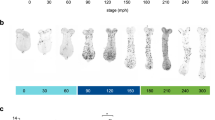Summary
The inhibitors of DNA synthesis change the differentiation of abdominal segments of the horseshoe crab and increase the number of segments in 90%–100% of the surviving embryos. The data suggest the following:
-
1.
The primordia of segments are formed one by one from the cells at the posterior end of the embryonic area, and they are determined soon after formation.
-
2.
When DNA synthesis inhibitors are applied, the forming primordium acquires a character intermediate between the anterior segment already determined and the segment next to be determined.
-
3.
The abnormal differentiation is possibly caused by a time lag between DNA synthesis and the rest of metabolism.
-
4.
The specific character of each segment of normal embryos and malformations successively determines that of the next segment.
-
5.
By this route the whole number of segments is established.
Similar content being viewed by others
References
Beachy PA, Helfand SL, Hogness DS (1985) Segmental distribution of bithorax complex proteins during Drosophila development. Nature 313:545–551
Cooke J (1978) Somite abnormalities caused by short heat shocks to pre-neurula stages of Xenopus laevis. J Embryol Exp Morphol 45:283–294
Cooke J, Zeeman EC (1976) A clock and wavefront model for control of the number of repeated structures during animal morphogenesis. J Theor Biol 58:455–476
Elsdale T, Person M, Whithead M (1976) Abnormalities in somite segmentation following heat shock to Xenopus embryos. J Embryol Exp Morphol 35:625–635
Goodwin B (1971) A model of early amphibian development. In: Davies DD, Balls M (eds) Br Soc Exp Biol Symposium 25. Cambridge University Press, pp 417–428
Itow T (1984) The induction of malformed embryos by inhibition of cell proliferation in the horseshoe crab, Tachypleus tridentatus. Acta Embryol Morphol Exp, pp 177–193
Itow T (1985) The effect of Ca2+ -free sea water on the body segmentation in the horseshoe crab (Chelicerata, Arthropoda). Acta Embryol Morphol Exp, pp 15–29
Itow T, Sekiguchi K (1980) Morphogenic movement and experimentally induced decrease in number of embryonic segments in the Japanese horseshoe crab, Tachypleus tridentatus. Biol Bull 158:324–338
Juberthie C (1968) Tératologie expérimentale chez un Opilion (Arachnide). J Embryol Exp Morphol 19:49–82
Lewis EB (1978) A gene complex controlling segmentation in Drosophila. Nature 276:565–570
Nüsslein-Volhard C, Wieschaus E (1980) Mutations affecting segment number and polarity in Drosophila. Nature 287:795–801
Oka H (1943) Recherches sur l'embryologie causale du Limule. II. Sci Rep Tokyo Bunrika Daigaku Sect B 6:87–127
Sekiguchi K (1973) A normal plate of the development of the Japanese horse-shoe crab, Tachypleus tridentatus. Sci Rep Tokyo Kyoiku Daigaku Sect B 15:153–162
Turing A (1952) The chemical basis of morphogenesis. Philos Trans R Soc Lond B 237:5–72
Wareing PF, Phillips IDJ (1981) Growth and differentiation in plants. Pergamon Press, Oxford
Author information
Authors and Affiliations
Rights and permissions
About this article
Cite this article
Itow, T. Inhibitors of DNA synthesis change the differentiation of body segments and increase the segment number in horseshoe crab embryos (Chelicerata, Arthropoda). Roux's Arch Dev Biol 195, 323–333 (1986). https://doi.org/10.1007/BF00376065
Received:
Accepted:
Issue Date:
DOI: https://doi.org/10.1007/BF00376065




